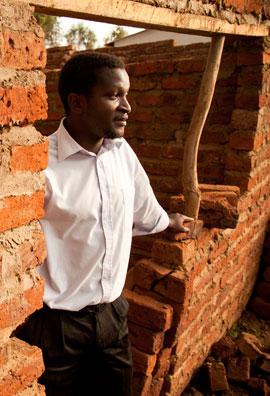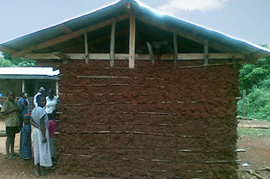Construction Technical Assistance in Malawi -- Habitat for Humanity Int'l 1
Construction Technical Assistance in Malawi
By Bob Longino
|
|

George Phiri, 28, is using technical construction training from Habitat along with microfinance loans from a Habitat partner to incrementally build a new home for his family in Lilongwe, Malawi. ©Habitat for Humanity/Steffan Hacker
|
|
|
|
|
|

A microfinance loan study in Ghana involving improvements done without construction technical assistance revealed that this home received a new roof improperly placed on a structure of mud walls that cannot properly support the addition. The home could collapse, the study said, or the roof could be blown off during a heavy storm. ©HFH Africa and the Middle East Area/Carl Queiros.
|
|
|
|
George Phiri, a 28-year-old teacher, stands in the brick entrance of what will become his first purchased home and smiles, thinking of the day that he, along with his wife, Beatrice, and their two small children, will move in.
To own a home instead of paying rent, as Phiri does now with another house, will mean a lot to him.
“It’s big. Very, very big,” Phiri says. “In Africa and in Malawi, not everyone owns a house. You waste money when you rent. So for me and my family to have our own house, it’s like you have taken one huge weight off your back.”
Phiri is part of Habitat for Humanity’s Construction Technical Assistance pilot program in Malawi. He’s using a series of microfinance loans from a Habitat fund partner along with technical building expertise from Habitat Malawi CTA staff.
Over time, he will build and complete his home and join the ranks of the hundreds of thousands of families Habitat has served worldwide.
The CTA program is different from the traditional model of Habitat home construction. The latter involves soliciting donated building materials, organizing volunteers to build alongside home partners, and financing the home with a no- or low-interest loan as part of a revolving fund.
The traditional model sees housing as a product — the house — and Habitat as the project manager and often builder, too.
In CTA, Habitat offers construction advice and products that help the homeowner build his or her own house. This can be advice on building materials and building practices such as proper foundations and proper roof support, the provision of a BOQ (bill of quantities), and house design. CTA is done in concert with a microfinance partner that lends the finances and oversees the loan aspect.
This model sees housing as a process, focusing on incremental building in a series of steps. Building in stages is by far the main way lower-income people improve housing in the developing world.
The contrast between Habitat’s traditional model and CTA indeed is stark. But the potential gain for Habitat in being able to increase the number of families helped each year is remarkable and provides a service that is far more affordable than the traditional model, says Carl Queiros, program development director for Habitat’s Africa/Middle East area office.
“Before Habitat Malawi started doing incremental housing and CTA a year ago, they could at best serve about 200 families per year,” Queiros says. “Through CTA and incremental housing, the future holds the potential to serve 2,000 to 3,000 a year.”
Further, a new global partnership between Habitat and Opportunity International, a Christian-based microfinance institution, opens up the possibility of working with a healthy portion of that organization’s client base, which numbers roughly 290,000 in Malawi alone.
Some 20 to 40 percent of OI’s microloans are income-generation or consumer loans that are diverted to home construction or improvement, meaning Habitat Malawi could become involved with thousands and even tens of thousands of new families.
“That’s huge,” Queiros says.
Although CTA as an intentionally designed and stand-alone model is very new, the basic idea has been used by Habitat for years, especially in Egypt, Nicaragua and other countries.
Now AME is developing technical assistance as a stand-alone program with its own system and philosophy.
Another pilot program is under way in Ghana, where the CTA staff is in the initial verification stage with its first client. But a completed study of Ghana loan practices by microfinance institutions done without construction technical assistance reveal many cases of improper building and wasting of funds by people who cannot afford to waste resources.
For example, one homeowner added a new roof to her existing house. The addition was not properly anchored, and the home’s mud walls did not provide good support, meaning the roof could “easily be blown off during a heavy storm,” or the house could collapse, the study said.
“One strong indication that people have a need for us is that MFIs are coming to us and saying, ‘We need your technical assistance and support,’” Queiros says.
By working with microfinance institutions, Habitat can leverage their capital for the finance segment and put the nonprofit funds solely toward technical assistance. Plus, Queiros says, MFIs “usually are better equipped and set up to manage loan programs and portfolios than we are and are so strong in many parts of Africa we can piggyback on their client base, expertise and infrastructure.”
In Malawi, the effect of Habitat’s CTA program can be registered by George Phiri’s wide smile as he looks over his nearly completed home.
He says Habitat advised him on a number of construction issues, including dealing with the land’s water table, use of cement and drainage needs.
“Without CTA,” Phiri says, “I’d still be on the foundation.”
Bob Longino is director of Creative Support Services for Habitat for Humanity International.